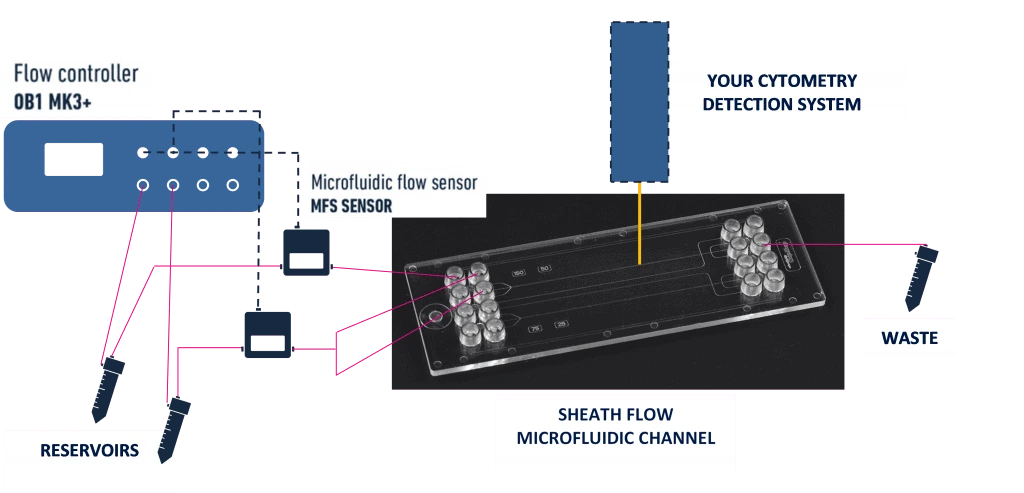Drawing adapted from Neil Dufton (wellcome collection CC BY 4.0); Sheath flow principle drawing by Torino et al. (2017)
MICROFLUIDIC FLOW CYTOMETRY INSTRUMENT PACK
Unbox, set up and start your experiments right away
Stable flow focusing thanks to our OB1 flow controller
Cell focusing in a narrow stream inside a wide channel
Microfluidic flow cytometry
Sheath flow focusing cytometry in a microfluidic channel is now available using the microfluidic flow cytometry Pack for detecting and measuring cells’ relevant chemical and physical characteristics with the possibility of sorting them. For example, cytometry can be used to discriminate if a cell died from necrosis or apoptosis or to perform cell proliferation assays.
Based on the fast and accurate Elveflow OB1 flow controller and a sheath flow chip, this all-in-one solution contains all the required microfluidic pieces for researchers to set up their microfluidics cytometry system with excellent sensitivity. Moreover, our microfluidic specialists will help you set up your platform with beginner-friendly advice and user guides.
Sheath flow streams aim to align the cells in the center of the microfluidic channel for cytometry. A standard sheath fluid flow focusing cytometry pack contains two pumping channels; the first is to push the sample to the microfluidic chip, and the second is for the sheath fluid. The stability of focusing is directly linked to the flow rates of the sample stream and the sheath streams.
Flow rates can be measured and regulated thanks to flow rate sensors from the MFS or the BFS series (Elveflow).
The microchannel material (either PMMA or COP) is optically transparent with low dispersion and birefringence that make it suitable for cytometry. Therefore, it is possible to set up a light detection system for cytometry directly on top of the microfluidic channel.
The possibility of cell sorting is thanks to the five outlet channels with two junctions that allow the collection of target cells at two different locations by applying positive or negative pressure at the outlet.
Flow cytometry pack setup
An all-in-one pack guarantees good compatibility between the different instruments, allows you to start your experiment immediately, is piloted by a single software, and can be used for other applications. These are a few arguments why a pack is the easiest way to setup a microfluidic experiment.

A typical flow cytometry pack contains:
- OB1 MK4 Flow controller (Elveflow)
- Two MFS flow sensors (or BFS flow sensor) (Elveflow)
- Three reservoirs
- Microfluidic chip from microfluidic ChipShop
- All necessary accessories: connectors, tubing, filters, etc…
- ESI control software (automated sequences possible) (Elveflow)
Microfluidic flow cytometry principle
Microfluidic flow cytometers have better portability and disposability than conventional devices, in addition to reduced sizes and costs [1]. This system is used to investigate single-cell level biological events and can also be used for cell sorting [2].
Microfluidic channels with laminar flows allow better accuracy and more stable flow control than conventional cytometry techniques like glass capillary-based systems [3]. The sheath fluid can also be air in a hydrophobic microfluidic channel (made with PMMA or COP) to create a disposable air sheath flow cytometry system [4].
Brillouin flow cytometry spectroscopy has been performed in a microfluidic channel to describe the mechanical properties of the cells [5].
Finally, integrated microfluidic cytometry has also been adapted for on-point measurements [6].
Advantages of microfluidics for flow cytometry
Conventional flow cytometry consumes large sample and reagent volume, making the experiment expensive. Moreover, classical flow cytometry systems are mechanically complex, requiring trained personnel for maintenance, and are usually complicated to customize for specific applications.
Microfluidics allows the fabrication of miniaturized flow cytometers that require less sample and reagent volume, which reduce the cost of the experiment and are suitable for implementation in remote environments. The microfluidic sheath flow cytometry system has an exceptional sensitivity for single-cell analysis as various detectors can be used to experiment.
Moreover, fluid properties can be precisely tuned at the microfluidic scale, and very stable focused sample flow can be achieved thanks to a strictly controlled flow rate on both the sample and the sheath streams.
Sheath flow cytometry can also be coupled with cell sorting directly in the same chip.
Microfluidic sheath flow cytometry allows more integrated, precise, and cheaper cell analysis.

References
- TD Chung, HC Kim, Recent advances in miniaturized microfluidic flow cytometry for clinical use, Electrophoresis 2007, 28, 4511–4520
- Fu, A. Y., Chou, H. P., Spence, C., Arnold, F. H., Quake, S. R., An integrated microfabricated cell sorter Anal. Chem. 2002, 74, 2451–2457.
- Huh, D., Gu, W., Kamotani, Y., Grotberg, J. B., Takayama, S., Microfluidics for flow cytometric analysis of cells and particles Physiol. Meas. 2005,26, R73–R98.
- Huh D, Tung Y-C, Wei H-H, Grotberg J B, Skerlos S J, Kurabayashi K and Takayama S 2002 Use of air-liquid two-phase flow in hydrophobic microfluidic channels for disposable flow cytometers Biomed. Microdevices 4141–9
- Zhang J et al., Brillouin flow cytometry for label-free mechanical phenotyping of the nucleus, Lab Chip, 2017, 17, 663
- Kiichi S., Akihide H., Mnabu T., Hideaki H., Takehiko K.; Microchip-based chemical and biochemical analysis systems, Advanced Drug Delivery Reviews, 55, 3, 24 February 2003, Pages 379-391
Customize your microfluidic flow cytometry pack
The sheath stream flow rate should be much higher than the sample stream flow to achieve a good cell separation and analysis.
The sheath flow cell sorting chip is available in poly(methyl methacrylate) (PMMA) or Cyclo Olefin Copolymer (COP) materials: these materials are both suited for cytometry, COP has better optical properties, and PMMA is slightly stronger.
There are two different chips with two channels available for each. The first one has a 50 µm depth structure in its first channel and a 25 µm depth in its second. The second one has both 30 µm depth channels.
Additional pumping channels for the OB1 flow control pump and flow rate sensors can be added to the pack if necessary.
Coriolis flow sensors can be chosen to replace the MFS to improve flow control.
Bubbles can be a problem for cells and cytometry; a bubble remover that tackles this issue can be provided if necessary.
Contact our scientists to answer any questions about this hydrodynamic focusing pack and how it can match your specifications.
– Check our other Packs for various applications –
How can we help your experiment?
The packs applications are still under development, so we are not able to give you the tips or troubleshooting advice that we usually give in our user guides and application notes for the possible challenges you could face for a specific application experiment. That being said, we can always guarantee reliable and high-precision microfluidic flow control. Our microfluidic instruments are high-performance, versatile and user-friendly. Our experts will bring support and expertise during the setup and implementation of this sensor calibration pack.
Can a pack be customized based on my specific application?
Yes! Our experts will establish which instruments are best suited for your application, such as the type of flow sensor or the number of flow controller channels you need to perform your experiment. Send us a message:
Can I buy individual packs?
You can order our packs on the product section of our website.